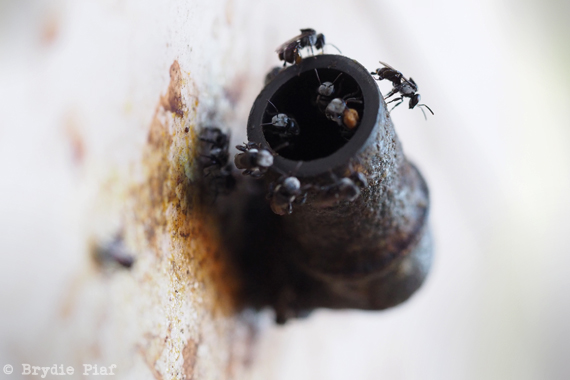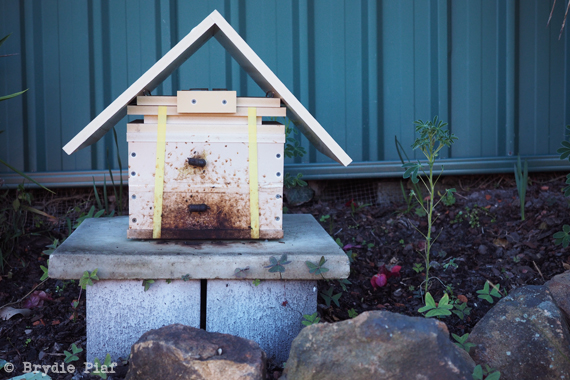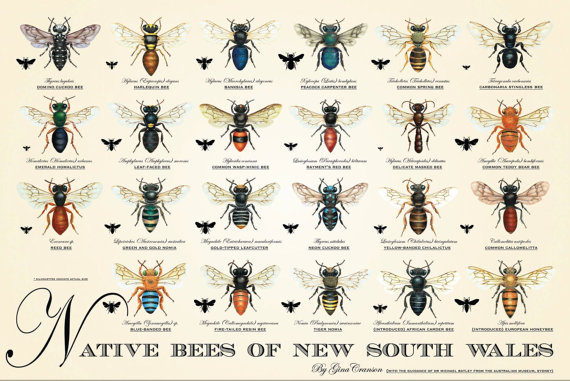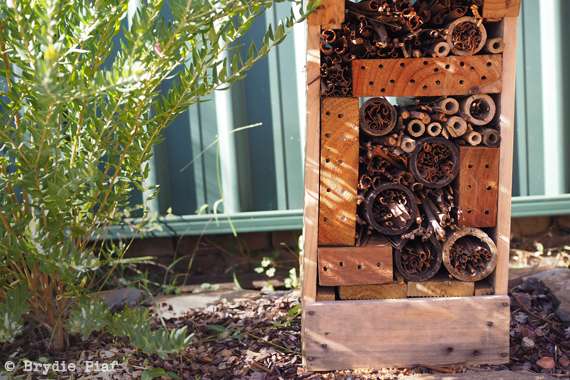I hadn’t seen the bees for awhile now. It being winter and actually feeling like winter, I’m like a concerned parent. Silently hoping for a day over 18 degrees, just so I can check in on them all, make sure the hive is ok. A reassuring healthy buzzing bee off on a foraging trip, that’s all I need to see.
That day comes, it’s warm, it’s crazy warm and the first thing I do after ripping my too hot woollen scarf draped around my neck is scamper up the hillside (err, slight slope in the very urban backyard but who’s paying attention to those details) to see if the bees are out. They are! My little native stingless friends are out and about and there is rather a lot of them.
In summer, first thing in the morning. I can sit outside, close my eyes, and hear a bunch of different bees and other pollinators amongst the tomato flowers. Opening my eyes I would often find a variety of different bees crowding a flower peppered plumbago. The hedge really should have been pruned back long ago but I can’t seem to do it with so many bees sourcing their daily foraging needs within the blue flower buds. It would feel a bit mean.
Ever since I did a Native Stingless Bee course, bees have been a constant source of intrigue and curiosity. Not just the native stingless ones, but the whole lot of them. European honey bees, solitary bees, they really are incredibly interesting creatures.
I adore this poster by Gina Cranson. Copies of the poster can be bought through a variety of places, but you can start with her Etsy site if you are keen, (there also now available QLD versions). One of these posters sits above my desk- learning the different types just by glancing at the pictures several times a day.
When we lived in Sydney, I had organised for our local council to fund some native stingless bee hives to set up residence within the school grounds. There were 3 when we left which opens up the possibilities for either splitting the hives and passing another on to another school or harvesting the honey. Either way it’s a wonderful lesson for school kids, and I’m hoping to do the same here at our new school.
Another option for bee lovers is to host a honey bee hive. Not technically yours for keeps, but a wonderful alternative, which gives a pollinated garden and proportion of the honey as a trade off. It’s a winning system I tell you.
More reading and information for all the bee enthusiasts out there
Earth Garden magazine frequently writes on a variety of our wonderful bees.
Awhile back I wrote about how to create your own Insect Hotel, over on Milkwood.
Tim Heard is the Native Stingless Bee master with his book The Australian Bee Book, (he also does frequent talks and workshops up and down the East Coast of Australia several times a year.)
Urban Hum hosts hives if you are in Newcastle, NSW.
Doug Purdie from The Urban Beehive, has you covered for all things honey bee related.





I’ve never heard of stingless bees. This is fascinating! I may have to look into them. I love the idea of having a beehive, but now that I own a resort, I really can’t have stinging insects buzzing around. I’ll have to look into this. Thanks for the idea!
LikeLike
A resort Ada? Well that’s a bit awesome! No idea if there are native bees in your area but do some research I say, and good luck with your new venture.
LikeLike
We keep our bees warm by adding some insulation to our hive. We use a cut down broccoli box to cover the top and sides.
LikeLike
How long have you had yours for Marilyn?
LikeLike
We’ve had them for a few years now. They seem to do quite well in this area (Lake Macquarie). Maybe this year we’ll be brave enough to do a hive split.
LikeLike
I was walking through our kitchen garden this morning and thinking how much I loved seeing bees, butterflies and birds around. How I love hearing the bees making the air sing when one of our many native trees and shrubs are flowering, which seems to be just about all year through.
Keeping hives on our 25 acre property is beyond me at the moment, but your beautiful post inspired me to ask around for local beekeepers that could. Turns out, there is quite a couple!
LikeLike
I think that’s a wonderful idea Marijke and a win win for both you and the beekeepers. Good luck, I hope you find someone!
LikeLike
Such amazing creatures Bridie. I thought the stingless ones were the ones that had been imported from Asia and were attacking our native ones. Glad to know we have some of our own too.
LikeLike
Nah. These are the good guys Tania. Any opportunity to keep a hive and help protect and preserve these bees in some way should be taken. Get some in for your backyard 🙂
LikeLike
Our insect hotels are a mix of spiders and “something” that plugs up the end of the holes with little bits of grass. It has been so cold and wet here in Tassie that it is unlikely we are going to see bees of any kind for a while but when the bumblebees resurface (wearing their aqualungs 😉 ) there isn’t a better noise. I wish we could get stingless bees here but it’s too cold for them. We do have teeny tiny little bumbling things that I like to think of as “bees” but I think that they are most likely those little cut flies. Oh well, I can live vicariously through your posts 🙂
LikeLike
Bumblebees are almost comical aren’t they. No still not a huge amount of bee action here either. It was warm for a few days and then back down to cold and windy, not what a bee likes at all.
And always happy for you to live vicariously through my posts Ms Narf.
LikeLiked by 1 person
Love your insect hotel and your little buzzy friends, Brydie. Glad to read that they are thriving. We have leaf cutter bees in our yard, and love to sit and watch them harvesting the rose leaves from our verandah to line their nests in summer. We found lots of ground hives of the big Dawson’s Burrowing bees while we were in the Murchison and got ridiculously excited, despite not managing to sight an actual insect myself (Grant did, lucky boy). Had only seen them on David Attenborough before.
LikeLike
It would be interesting to see a WA poster by Gina Cranson done on your bees Alison. I would how many of the solitary ones cross over from state to state or whether they are largely unique given the differences in the environment?
It is exciting when you spot a different one though. It’s a cracking way to start or end the day with a little bee spotting that 1/ you saw it in the first place and 2/ you can identify it.
LikeLike
Beautiful photos of these clever creatures Brydie. I adore that poster too. I have Doug Purdie’s book Backyard Bees and it is such a wonderful source of bee inspiration, although I think I am just too scared of stings to tackle beekeeping myself!
LikeLike
I love bees and it always makes me so happy when I see them buzzing around the verbena I planted and the lavender. I also hadn’t heard of non-stinging bees!
LikeLike
It’s lovely to hear bees amongst the flowers isn’t it Brydie. I’ve spotted a blue banded bee in our garden a few times – they get their bodies into a flower and sort of blow their little noses – that is, their whole body shakes and shakes the flower so that pollen lands on them – at least I think that’s what happens, it’s quite a distinctive sound and they seem to like blue flowers the most.
LikeLike
Jan I’ve only seen a blue banded bee a few times and each time there was a little happy dance when I did so. Ridiculously exciting 🙂
Will keep my eye out for their nose blowing next time I see them.
LikeLike
A friend of mine has several hives (and a few stings!) I would love to keep bees but I’m keeping an eye on Carrie’s for the moment and learning from her mistakes!
LikeLike
We’ve had our native bees for about 8months now and they are an endless source of joy and fascination for me too. Like you, I love to watch them and wait for them to emerge when the day is warm enough! Our bees love basil and rocket flowers and allysium blooms and there’s plenty of native blooms here for them too. We get honeybees, blue-banded bees and once we were lucky enough to spy a carpenter bee (that sounded like a mini-helicopter). Our son’s school recently got a native bee hive too and it’s a lovely thing to see the children watching and learning about these bees.
LikeLike
It really is Meg. My fingers and toes are crossed for our new school to embrace all things bees…they are just too important not to be incorporating them into our kids learning.
The carpenter bee is a big one eh…I’m on the look out!
LikeLike
Bees are such amazing creatures, it’s great to see so many different species of them. Having beehives is something I’m hoping to achieve one day, but until then I’ll have to stick to browsing other people’s pics!
LikeLike
Pingback: Best flowers to grow for you and your bees | cityhippyfarmgirl
Pingback: That’s a wrap | cityhippyfarmgirl
Pingback: Bee B&B Hotels in School | cityhippyfarmgirl